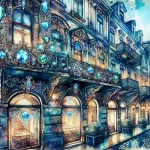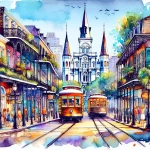Tucked within the lively allure of New Orleans lies a captivating world of hidden courtyards, each one a verdant haven transporting visitors through time. These secluded spaces, adorned with lush greenery and architectural wonders, exemplify the city’s storied heritage and are a must-visit for anyone seeking to truly experience the essence of the French Quarter.
In This Article
TL;DR
- The French Quarter’s courtyards hold immense historical significance, reflecting the city’s Spanish and French colonial influences.
- These tranquil oases boast unique architectural styles, featuring wrought-iron balconies, fountains, and brick pathways, complemented by meticulously maintained gardens.
- Visiting these hidden gems offers a glimpse into the cultural and social fabric of New Orleans, providing a respite from the bustling streets and an opportunity to immerse oneself in the city’s enchanting atmosphere.
Historical Context of French Quarter Courtyards
The origins of courtyard architecture in New Orleans can be traced back to the city’s colonial era, when the Spanish and French settlers brought their architectural traditions to the region. These courtyards served as central gathering spaces, providing shade, ventilation, and a sense of community within the dense urban landscape.
During the Spanish colonial period, the influence of Mediterranean architecture was evident in the design of these courtyards, with their emphasis on privacy, intricate ironwork, and lush vegetation. The French, on the other hand, introduced a more ornate and symmetrical approach, incorporating elements such as fountains, statuary, and formal garden layouts.
As the city evolved, these courtyards became integral to the cultural and social life of the French Quarter, serving as venues for intimate gatherings, artistic performances, and even clandestine meetings during times of political unrest.
Architectural Highlights of French Quarter Courtyards
The courtyards of the French Quarter showcase a variety of architectural styles, each one a reflection of the city’s storied heritage. From the Spanish-influenced patios with their intricate wrought-iron balconies and terracotta tiles to the French-inspired gardens with their symmetrical layouts and ornate fountains, these spaces offer a visual feast for the senses.
One of the most striking features of these courtyards is the intricate ironwork that adorns the balconies and gates. Crafted by skilled artisans, these intricate designs are not only aesthetically pleasing but also serve as a testament to the city’s rich metalworking tradition.
Brick pathways, often laid in intricate patterns, wind their way through the courtyards, leading visitors on a journey of discovery. These pathways are complemented by lush greenery, creating a harmonious blend of nature and architecture.
Botanical Aspects of French Quarter Courtyards
The courtyards of the French Quarter are not merely architectural marvels; they are also living, breathing spaces that celebrate the city’s diverse flora. From the towering oak trees that provide shade and respite to the vibrant bougainvillea cascading over wrought-iron trellises, these gardens are a true feast for the senses.
One of the most iconic plants found in these courtyards is the banana tree, a tropical delight that adds a touch of exotic flair to the surroundings. Other common plants include azaleas, camellias, and jasmine, whose fragrant blooms perfume the air with their intoxicating scents.
The maintenance of these courtyard gardens is a labor of love, with dedicated horticulturists and gardeners meticulously tending to each plant, ensuring that the spaces remain lush and vibrant throughout the year.
Iconic French Quarter Courtyards to Visit
While the French Quarter is home to numerous hidden courtyards, a few stand out as true gems that should not be missed.
The Court of Two Sisters, located in the lively center of the French Quarter, is a prime example of a beautifully preserved courtyard. With its lush gardens, bubbling fountains, and historic architecture, this space offers a serene escape from the bustling city streets.
Another must-visit courtyard is the one found within the Hotel Monteleone, a grand establishment that has been a fixture in the French Quarter since 1886. This courtyard, with its ornate ironwork and towering palms, is a true oasis of tranquility.
For those seeking a glimpse into the city’s past, the Beauregard-Keyes House is a must-visit. This historic home, built in 1826, boasts a stunning courtyard that has been meticulously preserved, offering visitors a window into the lives of New Orleans’ elite during the 19th century.
Planning Your Visit to French Quarter Courtyards
To truly appreciate the beauty and serenity of these courtyards, it is essential to plan your visit carefully. The best times of year to explore these spaces are during the spring and fall, when the weather is mild and the gardens are in full bloom.
It is important to note that some courtyards are located within private residences or hotels, and may have restricted access or require advance reservations. Others, however, are open to the public and can be explored at your leisure.
For those seeking a more immersive experience, guided tours are available, offering insights into the history, architecture, and cultural significance of these hidden gems. Alternatively, self-guided exploration can be a rewarding experience, allowing visitors to discover the courtyards at their own pace.
Cultural and Artistic Events in French Quarter Courtyards
Beyond their architectural and botanical splendor, the courtyards of the French Quarter also serve as vibrant cultural hubs, hosting a variety of events that celebrate the city’s rich artistic heritage.
During the spring and fall months, many of these courtyards come alive with the sounds of jazz, as local musicians take to the stage for intimate concerts. These events not only showcase the city’s musical legacy but also provide a unique opportunity to experience the music in a truly authentic setting.
Art exhibitions are also a common occurrence in these courtyards, with local and international artists showcasing their works amidst the lush greenery and historic architecture. These events offer a unique opportunity to immerse oneself in the city’s thriving art scene while surrounded by the beauty of these hidden spaces.
Preservation and Future of French Quarter Courtyards
As the city of New Orleans continues to evolve and modernize, the preservation of these historic courtyards has become a priority for local organizations and community groups. Efforts are underway to ensure that these spaces are maintained and protected for future generations, preserving not only their architectural and botanical significance but also their cultural and social importance.
One of the challenges faced in the preservation of these courtyards is the ever-present threat of urban development and gentrification. As the city grows and changes, it is crucial to strike a balance between progress and preservation, ensuring that these hidden gems remain intact and accessible to all.
Through community involvement, educational initiatives, and partnerships with local and national organizations, the future of the French Quarter’s courtyards looks promising. Ongoing projects aim to raise awareness about the importance of these spaces, while also providing opportunities for hands-on restoration and maintenance efforts.
Expert Insights and Additional Resources
To gain a deeper understanding of the French Quarter’s courtyards, it is invaluable to consult with experts in the field of New Orleans architecture and history. Historians and architects specializing in the city’s unique architectural heritage can provide invaluable insights into the design, construction, and cultural significance of these spaces.
For those seeking to further their knowledge, a wealth of resources is available, including books and documentaries that explore the rich history of the French Quarter. Online resources, such as virtual tours and interactive maps, can also provide an extensive overview of these hidden gems, allowing visitors to plan their explorations in advance.
By immersing oneself in the wealth of information available, visitors can truly appreciate the depth and complexity of these courtyards, enhancing their overall experience and deepening their connection to the city’s storied heritage.






